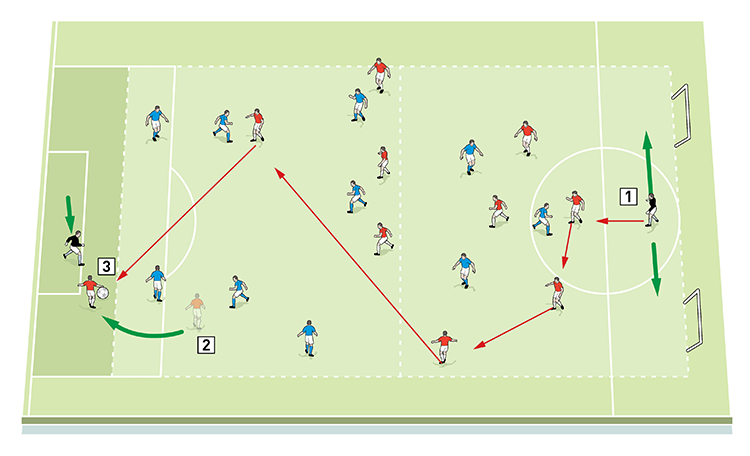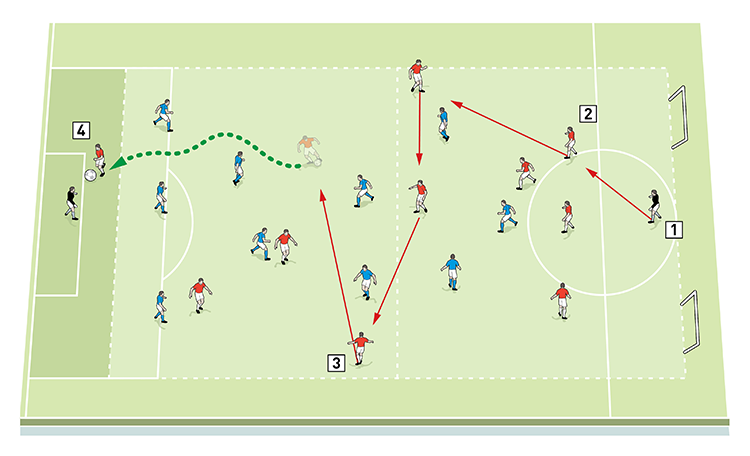




OUR BEST EVER OFFER - SAVE £100/$100
JOIN THE WORLD'S LEADING PROFESSIONAL DEVELOPMENT PROGRAMME
- 12 months membership of Elite Soccer
- Print copy of Elite Player & Coach Development
- Print copy of The Training Ground
Penetration in behind
It’s an engaging session for the players because it’s about creating and scoring goals and that’s what players love to do. It’s an attacking theme, based on expression and creativity with combination play, so players really enjoy it.
| Area | Up to full pitch |
| Equipment | Balls, bibs, cones, 2 small goals, 2 full size goals |
| No. of Players | Up to 20 players + 2 goalkeepers |
| Session Time |
Eliminating opponents: 5mins, Small space penetration: 15mins, Big space penetration: 15mins, 11v11 game: 20mins |
For any attacking team, exploiting space behind defenders is vital. This session is focused on developing players and teams to arrive in behind the opponents’ defence, either with or without the ball using the different ways you can do that, either by combination play or individual skill or running to receive a pass. The idea is to improve the patterns in order to go beyond the oppositions’ defence.
It’s an engaging session for the players because it’s about creating and scoring goals and that’s what players love to do. It’s an attacking theme, based on expression and creativity with combination play, so players really enjoy it.
What do I get the players to do?
Penetration: eliminating opponents
We set up a playing area of approximately 35x35 yards, positioning six cones as shown [1] and three mannequins representing opposition defenders. We’re using eight players, with three starting on the first cone and one each on the remaining cones. Players pass the ball in the sequence shown and then follow their pass with a run to the next cone. The passing should be directed to allow one-touch lay offs and to eliminate the presence of the mannequins.
1

2. The passing should allow players to make one-touch lay offs and to avoid the presence of the mannequins
3. After the ball completes a circuit, the first waiting player steps in to make the starting pass again and play continues
Small space penetration
We set up on half a pitch with a goal and a goalkeeper at one end. We mark out a 20x20-yard square near to the halfway line. We’re using 12 players split evenly into three teams of four. Two teams battle for possession in the square, while the third team has two players inside the square and two players outside it, all of whom play for the team in possession.
We start play with a pass into the square by the coach, as shown [2]. Players in the square are two-touch while the pair outside the square are restricted to one-touch. The team in possession has to make eight passes before one of its players can break out to attack the goal. The breakout player has only five seconds to score after receiving the final penetrating pass out of the square. The attacking player is all in during the final phase.
2

2. The yellows play for the team in possession. Two are outside the square and they are one-touch
3. The possession team has to make eight passes before an attacker can break out. Players in the square are two-touch
4. After receiving the final pass, the breakout attacker has five seconds to score past the keeper. He has unlimited touches
We play three games of four minutes.
What are the key things to look out for?
We can replicate an attack around the penalty area by making sure the pressing team includes two centre backs and the possession team is made up of forwards and central midfielders.
We want players making simple passes to retain possession. When off the ball, we expect to see blind side movements to penetrate behind the defenders.
If the possession team loses the ball we want to see fast and aggressive pressure from the attackers in transition to defence.
What do I get the players to do next?
Big space penetration
We set up on just over half a pitch coned off to the width of the penalty area. A goalkeeper is at one end in a 10-yard end zone, but he has no goal. Two small goals are positioned at the other end with one goalkeeper to guard both.
We play a game of 10v10 plus goalkeepers. One team attacks the end zone and defends the two small goals. They score two points for receiving a pass in the end zone, as shown [3a], and one point for dribbling into the zone, as shown [3b]. Players can only enter the end zone to receive a pass or if dribbling the ball in. If the other team wins possession, they must try to score in the small goals for one point, as shown [3c].
3a

2. Players should make blind side runs in behind the defensive line
3. Here the reds score two points for receiving a pass in the end zone. Players can only enter the zone to receive a pass or if dribbling the ball in
3b

2. Players are limited to three-touch in their own half
3. There is no limit on the number of touches in the opposition half
4. Here the reds score one point for dribbling into the end zone
3c

2. Players should use high quality passes to penetrate the opposition team’s defence
Teams are three-touch in their own half and have unlimited touches in the opposition half. We play two games of six minutes.
What are the key things to look out for?
We want to see players running in behind the defensive line and using high quality passes to penetrate the opposition. If players are failing to do this, we reinforce the importance during coaching breaks.
How would you put this into a game situation?
11v11 game
We set up between the penalty boxes of a full size pitch with a goal and goalkeeper at each end. We’re using 20 outfield players split into two team of 10 plus keepers.
We play a normal game [not shown] to put the session into focus and look to see if the coaching points have been learned. We play two games of eight minutes.
Related Files
Editor's Picks
Attacking transitions
Deep runs in the final third
Using the goalkeeper in build-up play
Intensive boxes drill with goals
Penetrating the final third
Creating and finishing
My philosophy
Pressing initiation
Compact team movement
Coaches' Testimonials

Alan Pardew

Arsène Wenger

Brendan Rodgers

Carlos Carvalhal

José Mourinho

Jürgen Klopp

Pep Guardiola

Roy Hodgson

Sir Alex Ferguson

Steven Gerrard
Coaches' Testimonials

Gerald Kearney, Downtown Las Vegas Soccer Club

Paul Butler, Florida, USA

Rick Shields, Springboro, USA

Tony Green, Pierrefonds Titans, Quebec, Canada
Join the world's leading coaches and managers and discover for yourself one of the best kept secrets in coaching. No other training tool on the planet is written or read by the calibre of names you’ll find in Elite Soccer.
In a recent survey 92% of subscribers said Elite Soccer makes them more confident, 89% said it makes them a more effective coach and 91% said it makes them more inspired.
Get Monthly Inspiration
All the latest techniques and approaches
Since 2010 Elite Soccer has given subscribers exclusive insight into the training ground practices of the world’s best coaches. Published in partnership with the League Managers Association we have unparalleled access to the leading lights in the English leagues, as well as a host of international managers.
Elite Soccer exclusively features sessions written by the coaches themselves. There are no observed sessions and no sessions “in the style of”, just first-hand advice delivered direct to you from the coach.







